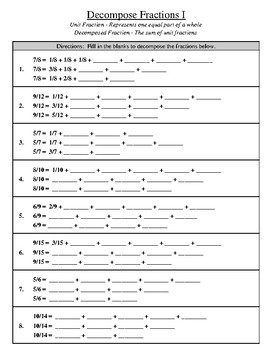

MA.4.FR.2.3: Explore the addition of a fraction with denominator of 10 to a fraction with denominator of 100 using equivalent fractions. MA.4.FR.2.2: Add and subtract fractions with like denominators, including mixed numbers and fractions greater than one, with procedural reliability. Demonstrate each decomposition with objects, drawings and equations. MA.4.FR.2.1: Decompose a fraction, including mixed numbers and fractions greater than one, into a sum of fractions with the same denominator in multiple ways. MA.4.FR.2 Build a foundation of addition, subtraction and multiplication operations with fractions. MA.4.FR.1.4: Plot, order and compare fractions, including mixed numbers and fractions greater than one, with different numerators and different denominators. Describe how the numerator and denominator are affected when the equivalent fraction is created. MA.4.FR.1.3: Identify and generate equivalent fractions, including fractions greater than one. MA.4.FR.1.2: Use decimal notation to represent fractions with denominators of 10 or 100, including mixed numbers and fractions greater than 1, and use fractional notation with denominators of 10 or 100 to represent decimals. MA.4.FR.1.1: Model and express a fraction, including mixed numbers and fractions greater than one, with the denominator 10 as an equivalent fraction with the denominator 100. MA.4.FR.1 Develop an understanding of the relationship between different fractions and the relationship between fractions and decimals. MA.4.NSO.2.7: Explore the addition and subtraction of multi-digit numbers with decimals to the hundredths. MA.4.NSO.2.6: Identify the number that is one-tenth more, one-tenth less, one-hundredth more and one-hundredth less than a given number. MA.4.NSO.2.5: Explore the multiplication and division of multi-digit whole numbers using estimation, rounding and place value. Represent remainders as fractional parts of the divisor. MA.4.NSO.2.4: Divide a whole number up to four digits by a one-digit whole number with procedural reliability. MA.4.NSO.2.3: Multiply two whole numbers, each up to two digits, including using a standard algorithm with procedural fluency. MA.4.NSO.2.2: Multiply two whole numbers, up to three digits by up to two digits, with procedural reliability. MA.4.NSO.2.1: Recall multiplication facts with factors up to 12 and related division facts with automaticity. MA.4.NSO.2 Build an understanding of operations with multi-digit numbers including decimals. MA.4.NSO.1.5: Plot, order and compare decimals up to the hundredths. MA.4.NSO.1.3: Plot, order and compare multi-digit whole numbers up to 1,000,000. MA.4.NSO.1.2: Read and write multi-digit whole numbers from 0 to 1,000,000 using standard form, expanded form and word form. MA.4.NSO.1.1: Express how the value of a digit in a multi-digit whole number changes if the digit moves one place to the left or right. MA.4.NSO.1 Understand place value for multi-digit numbers. (4) developing an understanding for interpreting data to include mode, median and range. (2) developing the relationship between fractions and decimals and beginning operations with both

(1) extending understanding of multi-digit multiplication and division
4th grade build and decompose fractions free#
A free teacher account also allows you to create playlists of games and assignments for students and track class progress.In grade 4, instructional time will emphasize four areas: You can access all of the games on Legends of Learning for free, forever, with a teacher account. IA preview of each game in the learning objective is found below. Use visual models to show that unit fractions compose fractions. Decompose a fraction into a sum of fractions with the same denominator. Concepts CoveredĪdding and subtracting fractions is similar to whole number computation in that it adds or subtracts two number line quantities. Scroll down for a preview of this learning objective’s games and the concepts.


This learning objective directly references 4.NF.B.3.b as written in the common core national math standards. The Fraction Decomposition learning objective - based on CCSS and state standards - delivers improved student engagement and academic performance in your classroom, as demonstrated by research.
4th grade build and decompose fractions series#
In this series of games, your students will learn to decompose a fraction into a sum of fractions with the same denominator in more than one way, recording each decomposition by an equation.


 0 kommentar(er)
0 kommentar(er)
